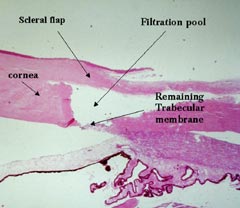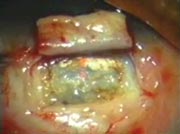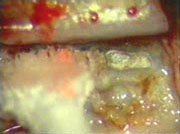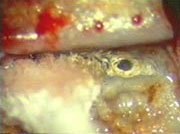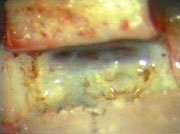Surgeon: CO2 laser may enhance nonpenetrating glaucoma surgery
Studies of the manual, nonlaser version of the technique showed pressure reductions only slightly smaller than trabeculectomy.
| ||
Nonpenetrating filtration surgery using a CO2 laser may be a safe alternative to manual nonpenetrating deep sclerectomy, according to one surgeon.
Ehud I. Assia, MD, director, department of ophthalmology at the Meir Hospital, Sapir Medical Center, Israel, discussed the use of the CO2 laser for performing a nonpenetrating deep sclerectomy (NPDS) during last year’s European Society of Cataract and Refractive Surgeons meeting.
He said manual NPDS involves scleral dissection to between 95% and 99% of the scleral depth, but not actual penetration. The endpoint is fluid percolation through intact tissue.
In performing NPDS using a CO2 laser, the laser is applied over the trabecular meshwork, ablating the scleral wall until aqueous percolates. Because the laser is almost completely absorbed by water, once the endpoint is reached, further laser application will theoretically not be effective, he said. This would help to avoid many intraoperative and postoperative complications, such as intraocular penetration, hypotony, bleeding, infection and inflammation, he said.
The laser technique remains in the first phase of clinical investigations, being performed at only two sites in Israel and South Africa. Three additional sites are expected to begin performing it soon, he said.
Dr. Assia said that because clinical experience using CO2 laser-assisted NPDS is limited, there may be potential complications of which he is not yet aware. But he said so far there have been no observed cases of significant tissue burns or coagulation-induced postop astigmatism.
“Overfiltration, hypotony and wound leak are obviously possible, but probably to a much lesser extent than penetrating surgery,” he said.
As with any NPDS surgery, NPDS using a CO2 laser is indicated only for open-angle glaucoma. Also, because it is an investigational procedure, only poorly sighted or legally blind eyes are being treated, he said.
“If this procedure indeed proves to be safe and effective, we hope it will also be used in the early stage of glaucoma therapy, saving patients from the need to use eye drops for many years. Surgery is known to work much better in virgin eyes not previously treated by medications, and to reduce pressure more effectively than topical medications,” Dr. Assia told Ocular Surgery News.
Manual vs. laser NPDS
Dr. Assia said a manual NPDS involves dissecting a half-thickness scleral flap followed by dissection and removal of a second section of deeper scleral lamella, down to almost the level of the uveal tissue. The second dissection is done to create what he called a filtration pool that exposes the outer wall of Schlemm’s canal and the peripheral Descemet’s membrane.
Mechanical unroofing of Schlemm’s canal facilitates fluid percolation through the exposed area of tissue, he said.
“If the second dissection is not deep enough, it may not be effective. If it is too deep, it may penetrate into the uveal wall or into the anterior chamber. The distance between success and failure may be on the magnitude of several tens of microns,” he said.
Dr. Assia said the procedure also requires a high level of surgical skill and experience. There is a significant learning curve, and initially perforations may occur in up to 30% of cases. The procedure is also time-consuming.
Performing NPDS using a laser is basically a different surgery than mechanical or manual NPDS, he said.
Mechanical surgery is mainly anatomical and requires careful identification of the dissected tissues. In contrast, surgery using the laser is more functional because scleral tissue is ablated until fluid begins to percolate. The operation ends when the desired functional endpoint is achieved, which is effective fluid percolation and not removal of a specific layer of tissue, he said.
“Also, since the laser energy is absorbed in water, the laser effect ceases when percolation starts,” Dr. Assia said. “This is the basis of the higher safety profile of this procedure. If done correctly, NPDS is practically an extraocular surgery, which eliminates many of the potential sight-threatening complications of conventional trabeculectomy, such as infection, bleeding, flat anterior chamber and hypotony.”
| First clinical case, Israel site | |
|
|
|
|
|
|
| Images courtesy of Ehud I Assia, MD. | |
Initial clinical results
Dr. Assia said most studies have shown that clinical results using manual NPDS are only somewhat inferior to penetrating trabeculectomy. However, the somewhat lower efficacy should be weighted against the higher safety profile.
According to Dr. Assia, initial results using the CO2 procedure in humans have shown some promising results as well. In one case, a patient with a preoperative IOP of 28 mm Hg who was treated by Elie Dahan, MD, of Johannesburg, South Africa, attained an IOP of 7 mm Hg on the first postop day. After 1 month, the patient had an IOP of 9 to 10 mm Hg.
In Dr. Assia’s first clinical case performed at his site in Israel, the patient experienced a decrease in IOP from 30 mm Hg preop to 1 mm Hg at 1 day postop. The patient’s IOP increased to 7 mm Hg at 1 week follow-up and to 11 mm Hg at 1 month.
In a second case, a patient with a narrow angle decreased from a preop IOP of 35 mm Hg to 16 mm Hg postop.
He said results could be improved by using several intraoperative and postop strategies, such as spacers to maintain the filtration lake, antimetabolites to prevent fibrosis, viscocanalostomy to reopen Schlemm’s canal and YAG goniopuncture to open the canal after the external wound is sealed.
Postop care is generally similar to a conventional trabeculectomy, namely using steroids or nonsteroidal anti-inflammatory drugs for several weeks. Also, close follow-up is recommended for early identification and treatment of any pressure elevations.
In the event that NPDS does fail, patients can still be treated by YAG goniopuncture, needling or antimetabolite injection. Surgery can also be repeated at the same location or at another site, and medications can be added to augment the pressure reduction.
Penetrating trabeculectomy or another surgical option can also be used at any time, he said.
For Your Information:
- Ehud I. Assia, MD, can be reached at Department of Ophthalmology, Meir Hospital, Sapir Medical Center, Tsharnihovski St. 44281, Kfar Saba, Israel; +972-9-747-1527; fax: +972-9-747-2427; e-mail: assia@netvision.net.il.

